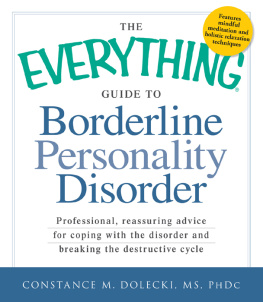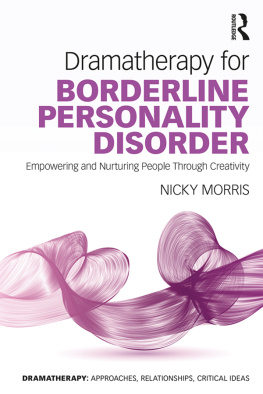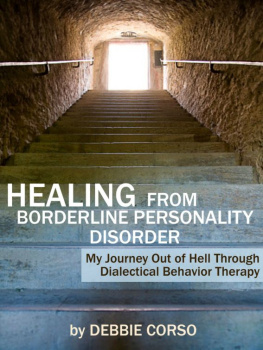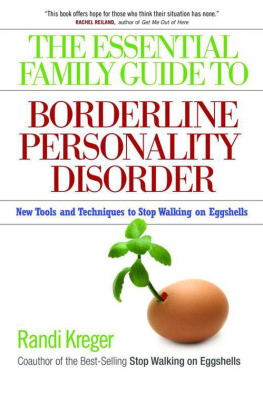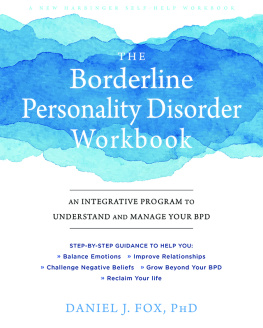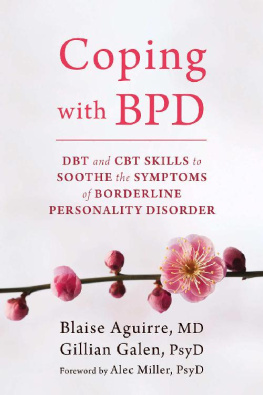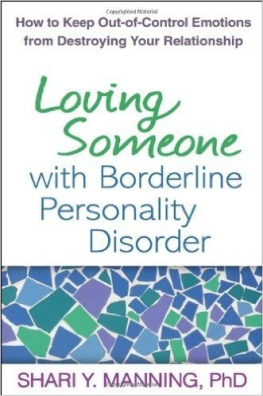A Practical Guide to Understand Borderline Personality Disorder
How Dialectical Behaviour Therapy Can Help Borderline Personality Disorder
By: Paterson Keith
Table of Contents
Publisher Notes
Disclaimer
This publication is intended to provide helpful and informative material. It is not intended to diagnose, treat, cure, or prevent any health problem or condition, nor is intended to replace the advice of a physician. No action should be taken solely on the contents of this book. Always consult your physician or qualified health-care professional on any matters regarding your health and before adopting any suggestions in this book or drawing inferences from it.
The author and publisher specifically disclaim all responsibility for any liability, loss or risk, personal or otherwise, which is incurred as a consequence, directly or indirectly, from the use or application of any contents of this book.
Any and all product names referenced within this book are the trademarks of their respective owners. None of these owners have sponsored, authorized, endorsed, or approved this book.
Always read all information provided by the manufacturers product labels before using their products. The author and publisher are not responsible for claims made by manufacturers.
Copyright 2014 Paterson Keith - All rights reserved.
DEDICATION
This book is dedicated to all those who have contributed to make this possible.
Introduction
Borderline personality disorder (BPD) also called the emotionally unstable personality disorder; BPD is also termed as emotional intensity disorder.
PICTURE 1: EMOTIONALLY UNSTABLE PERSONALITY DISORDER
This disorder is the impact of someones impulse to interpersonal relatioinship and self image. Usually, the patterns of behaviour appear in early adulthood and can happen over a variety of scenarios and varying situations.
BPD is a mental illness that causes impulsive behaviors, very intense mood swings, and severe problems with self-worth. The signs begin to appear in childhood. But the real issues usually begin at early adulthood. Treatment might be difficult and may take a little longer.
Experts on behavioural or personality disorders state that these kinds of disorders are usually enduring, pervasive, and have patterns of inflexibility. Theres a reluctance to diagnose a disorder in a persons personality before early adulthood, however, experts still emphasize that without early treatment, symptoms might worsen.
This mental health disorder always makes a person have a significant level of emotional instability. BPD can also lead to different kinds of stressful behavioral and mental issues. A person who suffers BPD has the tendency to distort self-image, or they might feel worthless on most occasions.
They abruptly experience anger, impulsiveness, and varying mood swings frequently. In some cases, people with BPD have a significant issue with relationships, even if they desire to have lasting connection to someone, they may still push them away and cut the relationship.
Other signs and symptoms that goe with BPD is the feeling of intense fear of being abondoned, yet they feel irritable, and at times, they feel intense anger, which at times is very hard to understand.
People with BPD also have the tendency to engage in devaluation and idealization of others, usually the alternation of a disappointment and a positive regard. BPD can also induce self-harm and suicidal tendencies.
Historical Overview
Divergent and intense moods of an individual was sighted by Hippocrates, Homer, and Aretaeus, which they described that there is a wavering presence of impulsive anger, mania, and melancholia within a single person. It was then followed by studies that described a phenomenon of unstable moods, which was then followed by unpredictable hesitations.
Then, the studies of others like the American psychiatrist C. Hughes and J.C. Rosse who called the personality disorder borderline insanity. In 1921, Kraeplin identified a behaviour which parallels with the features of the current concept of BPD, and called it excitable personality.
Adolf Stern in 1938, also used the term borderline with the sudy of a group of patients of whom he thought were suffering a mild condition of schizophrenia, a borderline disorder between neurosis and psychosis.
During the 1960s and 1970s, experts saw a significant shift from thinking of the condition as borderline schizophrenia into viewing itit as a borderline affective disorder or just a mood disorder, which they saw it as just at the fringes of bipolar disorder. With the stressing the intensity of moods, it was called the Cyclothymic Personality or affective personality.
While the term "borderline" was evolving to be referred as a distinct and specific category, experts in psychological behaviors like Otto Kernberg were now using Borderline for issues of a broad spectrum of intermediate level of and individuals personal regard and organization, between neurosis and psychosis.
After a standardized criterion was developed, BPD became a personality disorder diagnosis in 1980. It was then diagnosed from a distinguished form of sub-syndromal schizophrenia, which was then branded as "Schizotypal Personality Disorder.
Before long, the DSM-IV Axis II Work Group of the American Psychiatric Association had decided to name the condition as borderline personality disorder". However, the term "borderline" was still in debate because of the inadequate description of the symptoms and characteristic of the mental, personality, or behavioural disorder.
CHAPTER 1
Borderline Personality Disorder
The condition of having a Borderline Personality Disorder always affects how a person feels about themselves; it affects the relation to others, especially how they behave in stressful and relaxed situations.
PICTURE 2: BORDERLINE PERSONALITY DISORDER
There are a lot of signs and symptoms that you can see if you or your friend has BPD. The symptoms of this disorder include instability in the persons interpersonal relationships, emotion, mood swings, self-image projection, and an unstable pattern of impulsive behaviors.
Individuals with BPD experience the symptoms in their young adult life, and they can continue on for years.
Symptoms of Borderline Personality Disorder
Sensitive to Abandonment
The person has the fear of being left alone or being abandoned by a loved one or by their friends. They often imagine or believe that others around them are leaving, even if they are not.
For example, they physically cling themselves to others in an attempt to avoid abandonment.
Very Unstable Relationship
While in intense connections or relationships, they usually have the tendencies of breaking up, or they experience a lot of conflict during the relationship. People who might be suffering BPD also experience frequent arguments with family, relatives, and friends.
For example, they have a feeling of needing someone or needing to get away from someone; they always experience negative emotions during the ups and downs of a relationship. In other words, they often feel hatred or disappointment toward a loved one.


